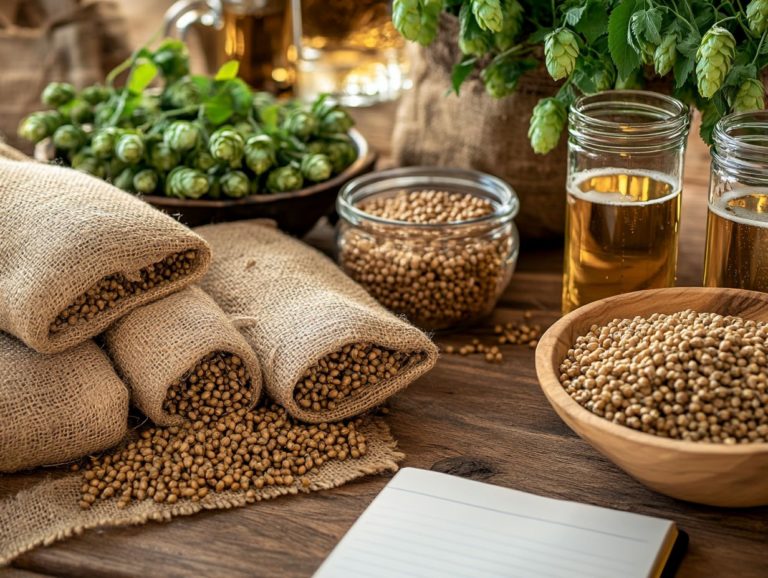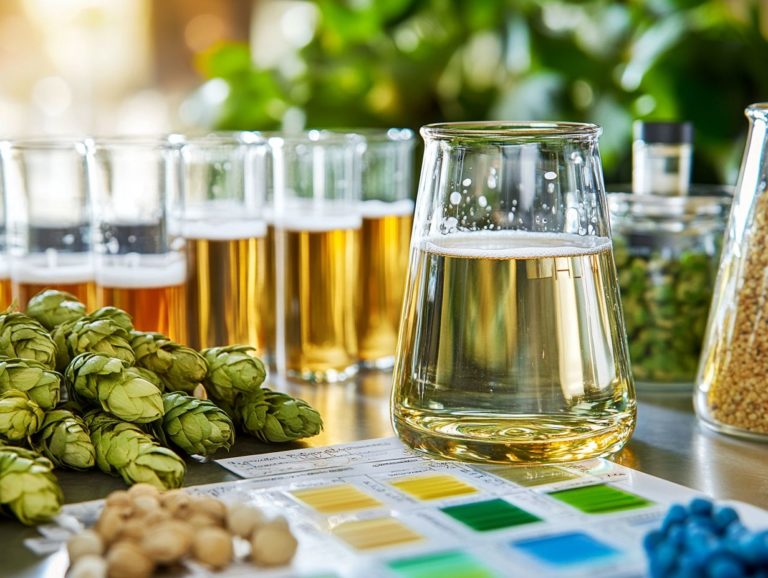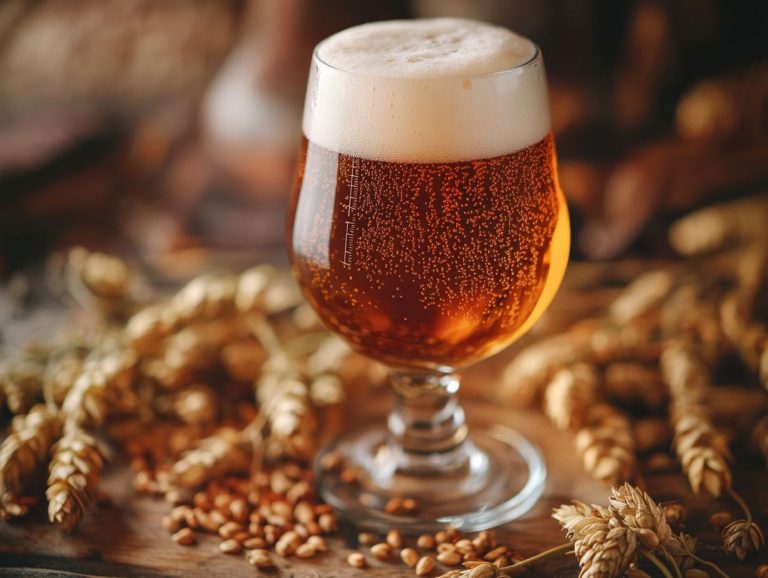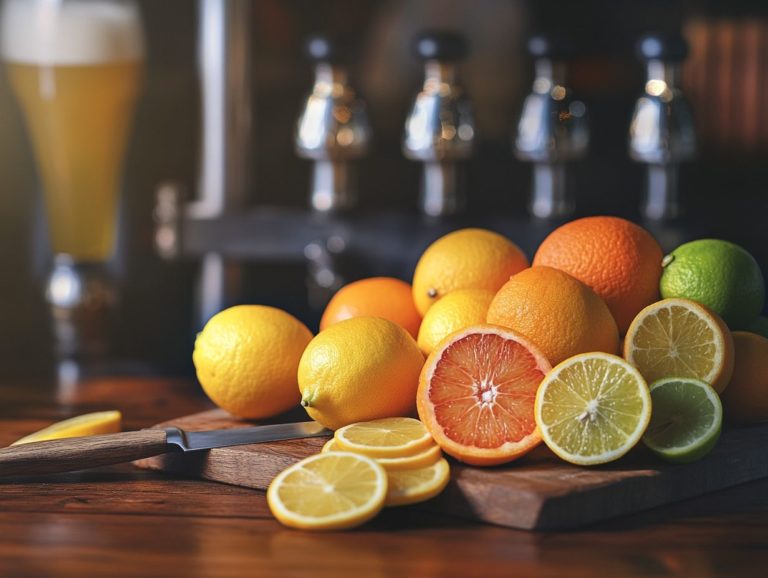Using Adjuncts: Enhancing Your Home Brew
Contents
- Home Brewing with Adjuncts
- What Are Some Popular Adjuncts Used in Home Brewing?
- Grains (Barley, Wheat, Oats, etc.)
- Sugars (Corn, Honey, Molasses, etc.)
- Enhancing Your Home Brew with Flavor
- Unlock Your Brewing Potential with Adjuncts
- Frequently Asked Questions
- What are some common adjuncts used in home brewing?
- How do I decide which adjuncts to use in my home brew?
- Can I use too many adjuncts in my home brew?
- How do I add adjuncts to my home brew?
- Are there any adjuncts that should be avoided in home brewing?
Home Brewing with Adjuncts
Home brewing is not just a hobby; it s a creative adventure! Elevate your brews by incorporating exciting extra ingredients that can transform your beer from ordinary to extraordinary. Whether it’s adding unique spices, fruits, or grains, each extra ingredient can bring a distinct flavor to your brew.
This article will delve into the myriad benefits of using extra ingredients, explore the various types available, and guide you on how to select and seamlessly incorporate them into your home brewing process. Understanding the role of extra ingredients in the brewing process can greatly enhance the quality and complexity of your beer.
Whether you re looking to add a unique twist to a classic recipe or enhance a familiar flavor, extra ingredients will serve as your secret weapon in crafting exceptional brews. From adding creative brewers’ touches with chocolate and coffee to experimenting with seasonal fruits and vegetables, the possibilities are endless.
Key Takeaways:
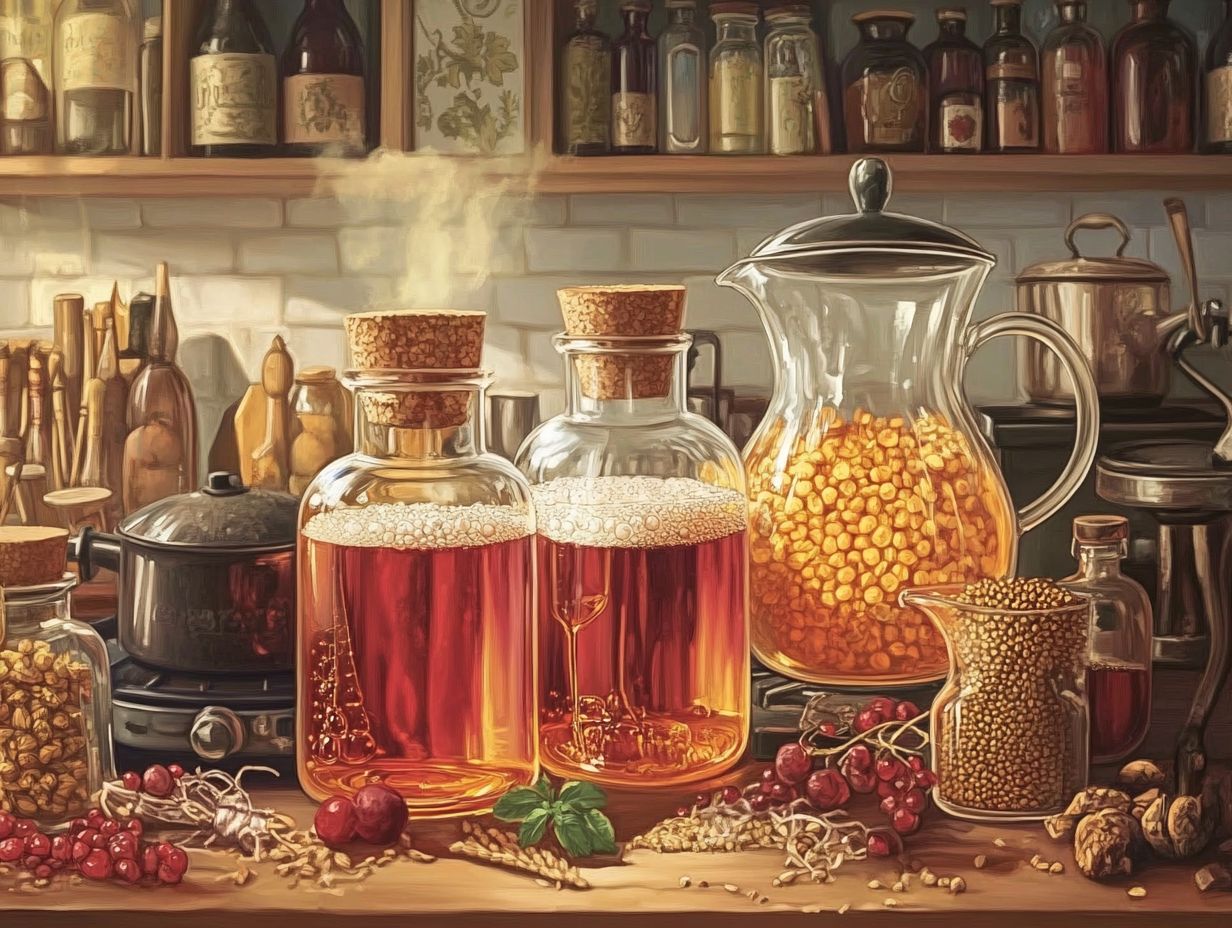
- Enhance your home brew by using extra ingredients to add unique flavors and aromas.
- Consider the type of beer you are brewing, your desired flavors, and your budget when choosing extra ingredients.
- Experiment with different combinations and use extra ingredients to balance flavors in your home brew to create a unique and delicious beverage.
Why Use Extra Ingredients in Brewing?
Using extra ingredients in brewing presents an exceptional opportunity to elevate the complexity and uniqueness of your beer. Don’t miss the chance to explore incredible flavors and craft beers that will impress your friends!
Extra ingredients can encompass a diverse array of components, including grains, sugars, and spices. This gives you, as a creative brewer, the power to craft distinctive beers that resonate with seasonal trends or your personal palate. From malt and hops to yeast and water, each ingredient plays a pivotal role in the brewing process.
In a competitive market, craft breweries frequently turn to extra ingredients to set themselves apart, skillfully embracing innovation while staying true to the fundamental principles of the brewing process. This includes experimenting with brewing extras like yeast, bacteria, and herbs to create unique and compelling beer styles.
What Are the Benefits of Using Extra Ingredients?
The benefits of using extra ingredients in brewing are abundant. They provide you with opportunities to enhance flavor profiles, improve mouthfeel, and diversify the brewing process. This leads to a wider array of beer styles for you to savor.
Creative brewers often experiment with extra ingredients like chocolate, coffee, and various fruits to create unique aromas and distinct flavors. They maintain a strong focus on the fermentation process.
Take, for example, a rich oatmeal stout; it truly flourishes with the addition of oatmeal, resulting in a smooth and creamy mouthfeel that pleases the palate.
Using brewing sugars like lactose can enhance the sweet taste in milk stouts. Fruit-forward IPAs frequently feature citrus or tropical fruits, amplifying the hop character while introducing refreshing layers of complexity.
Incorporating extra ingredients like pineapple or toasted coconut can create a beer that stands out in the craft beer market.
Cost efficiency plays a crucial role as incorporating extra ingredients can reduce overall production costs while simultaneously enhancing the appeal of the final product. Notable examples include celebrated beers like Founders’ Porter, which leverages chocolate for added depth, and Ballast Point s Grapefruit Sculpin, where grapefruit perfectly complements the hop bitterness, captivating beer lovers with its extraordinary flavor spectrum.
These examples highlight how extra ingredients can transform the original wort into a masterpiece.
Types of Adjuncts: Discover the Options!
Different types of adjuncts (additional ingredients used in brewing) can profoundly influence your final brew, encompassing categories that include grains like barley, corn, wheat, and rice; various sugars such as lactose and honey; fruits like pumpkins and berries; and spices that add layers of complexity to the flavor profile. By familiarizing yourself with the range of available adjuncts, you can craft unique and flavorful brews that truly stand out in the market.
When you categorize adjuncts into these distinct groups, you gain an appreciation for how each element contributes to the overall nature of the beer. For instance, barley acts as a foundational grain, imparting a delightful malt sweetness, while corn can lighten the body and enhance drinkability. Sugars like lactose bring a creamy mouthfeel and a touch of residual sweetness, which are particularly favored in milk stouts.
Fruits, whether it’s seasonal pumpkins or vibrant berries, infuse your creations with refreshing tastes and enticing aromas. Meanwhile, spices such as coriander, cinnamon, or ginger provide intriguing depth. This thoughtful selection of adjuncts not only diversifies your brewing palette but also captivates consumers with exciting flavor profiles, nurturing a deeper appreciation for the artistry that goes into each brew.
Choosing the Right Adjuncts for Your Homebrew: Tips and Tricks!
Selecting the right adjuncts for your homebrew is a crucial step in the brewing process that can greatly elevate the final product. Whether you’re crafting a seasonal beer or a distinctive brew that highlights unique flavors, it’s essential to make informed choices. Consider factors such as the type of beer you intend to create, the specific flavors you wish to introduce, and your budget. These elements will serve as your compass, guiding you toward the adjuncts that best align with your brewing aspirations.
What Flavors Do You Want to Add?
When you re choosing the flavors to infuse into your homebrew, it s essential to consider the array of adjuncts at your disposal and how they can craft distinctive profiles that enhance your beer s character. From the fundamental ingredients of malt, hops, yeast, and water to creative additions of vegetables, herbs, and bacteria, each element contributes to the final product. From the indulgent richness of chocolate and the bold punch of coffee to the refreshing accents of seasonal fruits and spices, each adjunct plays a vital role in shaping the overall flavor and aroma, giving you the power to create brews that are both original and unforgettable.
Take, for example, the captivating addition of vanilla beans. They can transform stouts into creamy, dessert-like delights, while zesty citrus peels breathe life into pale ales with their bright, aromatic flair. Picture the delightful pairing of toasted coconut and pineapple, whisking your palate away to a sun-drenched tropical paradise. Alternatively, imagine the cozy warmth of cinnamon and nutmeg in a spiced brown ale, ideal for those chilly evenings.
These adjuncts don t just enhance flavor; they conjure a sensory experience that dances between the familiar and the adventurous! Experimenting with various adjuncts can unlock a realm of flavor possibilities that truly define your unique style as a brewer.
What Type of Beer Are You Brewing?
The type of beer you brew is crucial in guiding your choice of adjuncts, as different styles demand specific flavor profiles and characteristics to achieve that perfect balance and harmony during fermentation. Whether you are a homebrewer or part of a craft brewery, making informed decisions about adjuncts can significantly impact your brew’s success.
For instance, if you’re brewing a stout, you might consider incorporating chocolate or coffee adjuncts to elevate its rich, dark essence. Conversely, when crafting a fruit beer, adding seasonal fruits can impart a refreshing twist that enhances its character.
Lagers often flourish with subtle adjuncts like corn or rice, which lighten the body and create a crisp finish, making them ideal for those refreshing summer brews. On the flip side, hoppy IPAs can benefit from floral or citrus zests, creating a delightful contrast that accentuates the natural characteristics of the hops.
These selections not only shape the aroma and taste but also influence the overall mouthfeel and complexity of the final product. By carefully choosing adjuncts that complement your chosen style, you can craft unique and memorable experiences that truly resonate with beer enthusiasts.
Don’t miss the chance to experiment with these delightful adjuncts! Each choice can lead you to a new brewing adventure and an exciting flavor journey.
In conclusion, understanding the different types of adjuncts and how to select them wisely can make all the difference in your brewing process. Dive into the world of adjuncts, and let your creativity flourish as you craft your next unique brew!
We encourage you to share your brewing experiences and the unique adjuncts you’ve tried on social media or forums!
What Is Your Budget?
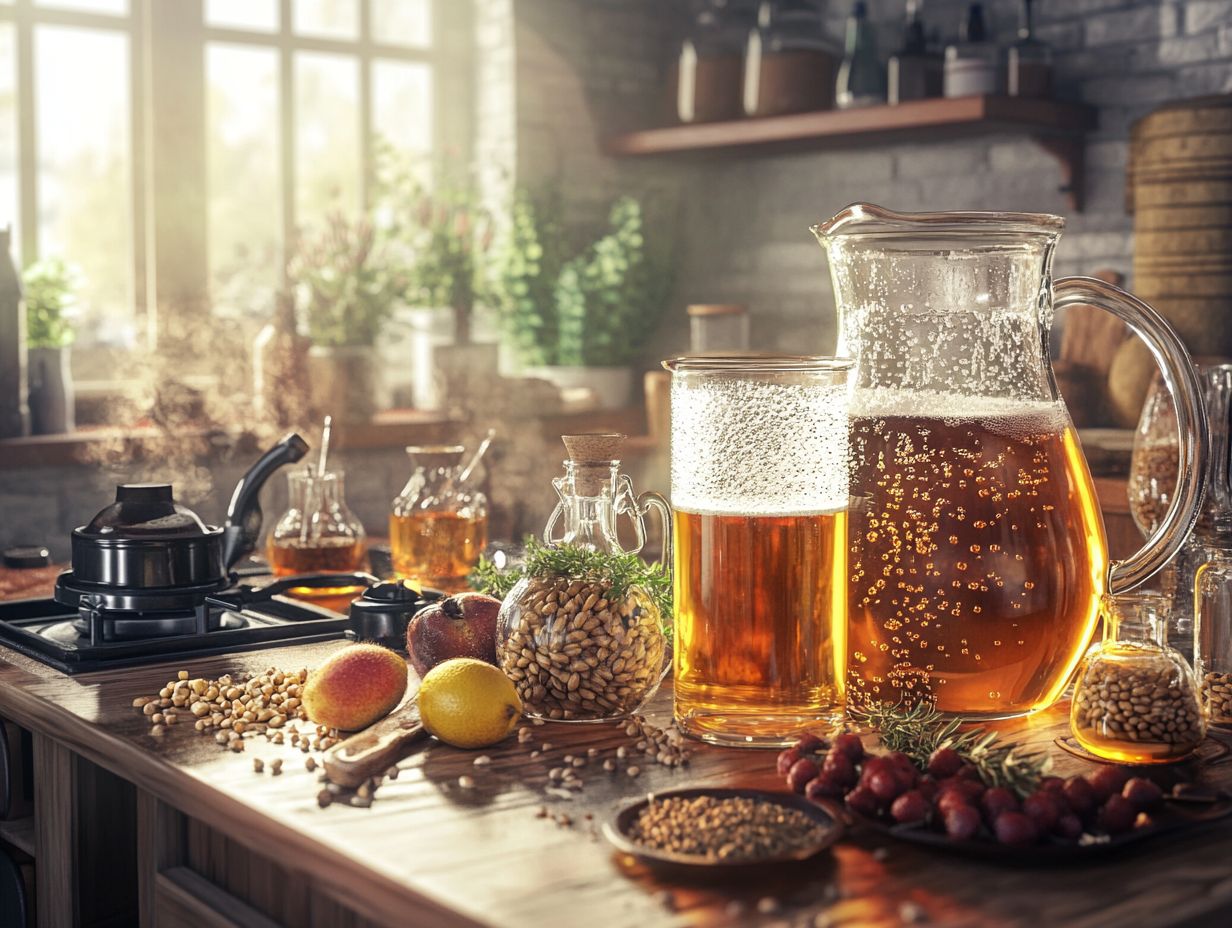
Your budget plays a pivotal role in selecting additional ingredients (adjuncts) for brewing, determining the array of ingredients you can incorporate into your homebrew. By understanding the costs associated with various adjuncts whether they be specialty grains or exotic fruits you can craft a balanced recipe that stays true to your flavor aspirations without straying from your financial limits.
To maximize your resources, consider exploring local suppliers and farmers’ markets for fresh ingredients; you may find better prices than commercial channels. Embracing bulk buying options can also lead to significant savings, particularly for frequently used adjuncts like grains and hops.
Use social media groups and community brewing clubs as excellent avenues for discovering budget-friendly alternatives and accessing recipes that maintain the quality of your final product. And remember, innovation often springs from necessity experimenting with seasonal ingredients can yield unique flavor profiles while keeping your costs in check. Act quickly to explore local suppliers!
How to Use Adjuncts in Your Home Brew?
Incorporating adjuncts into your homebrew demands a thoughtful approach and a solid grasp of the brewing process to ensure they blend seamlessly, ultimately elevating the flavor and aroma of your beer.
You need to carefully choose the right adjuncts and pinpoint the optimal moment for their introduction be it during the mash (the process of soaking grains in water to extract sugars), boil, or fermentation stage.
By strategically integrating these adjuncts, you can craft a beer that genuinely embodies your unique brewing vision.
What Is the Process of Adding Adjuncts to Your Brew?
The process of adding adjuncts to your brew can be an art form, varying based on the type of adjunct and your desired outcome. Generally, you’ll want to integrate them at specific stages of the brewing process to maximize their flavor contributions. This includes carefully managing the fermentation tank to ensure adjuncts like sugars, hops, and spices blend seamlessly.
Whether you’re adding brewing sugars during fermentation for a sweeter finish or incorporating spices during the boil for that aromatic depth, understanding how to effectively introduce adjuncts can lead to a well-balanced beer that truly showcases the flavors and aroma you intend.
From the initial mash stage, where you might complement grains with specialty grains or flaked adjuncts to enhance body and mouthfeel, to the boiling phase where fruits, vegetables, and herbs can infuse complex notes, every moment in the brewing process is crucial.
As fermentation progresses, careful timing becomes key; introducing honey or maple syrup too early could create fermentation hiccups. However, adding them at just the right moment can significantly enhance sweetness and aroma in your final product. This is particularly important in adjunct beer recipes where distinct flavor profiles are desired.
This thoughtful approach not only honors the unique character of each adjunct but also equips you with dynamic tools to craft distinctive brews that will undoubtedly resonate with flavor enthusiasts and creative brewers alike.
What Are Some Common Mistakes to Avoid When Using Adjuncts?
When incorporating brewing adjuncts in your brewing endeavors, it s crucial to avoid common pitfalls to achieve the perfect flavor balance and elevate the overall quality of your beer. Miscalculating the quantity of adjuncts, adding them at the wrong stage of the brewing process, or neglecting their unique characteristics can result in unpleasant flavors, fermentation imbalances, and ultimately, less-than-stellar results.
You might be tempted to underestimate the impact that adjuncts can have, thinking that any ingredient will blend effortlessly into your brew. It s essential to thoroughly research the adjuncts you choose; whether it’s oats or fruit, each ingredient introduces distinct flavors and sugars that can dramatically alter your beer s profile.
Timing is another crucial factor; introducing an adjunct too early or too late can significantly influence the taste and complexity of your final product. Experimenting with small batches is an exciting way to learn! This approach allows you to closely observe how adjuncts interact throughout the fermentation process, refining your technique and leading to a far more gratifying brew.
What Are Some Popular Adjuncts Used in Home Brewing?
As a homebrewer, you’ll find a wealth of popular adjuncts at your disposal to craft distinctive flavors and aromas in your brews. These adjuncts, which include grains, sugars, fruits, spices, and various other flavorings, elevate the complexity of your beer. They invite you to experiment with seasonal ingredients and enhance your brewing creativity.
This opens the door to unique creations that resonate with craft beer enthusiasts. Get ready to explore!
Grains (Barley, Wheat, Oats, etc.)
Grains like barley, wheat, and oats form the backbone of many beer styles. When used as adjuncts, they unlock unique flavors and textures that elevate your brewing experience. By experimenting with various grains and adjuncts, you can create variations that affect mouthfeel and sweetness, ultimately shaping your beer’s distinctive character.
For example, corn and rice lighten the body and provide a crisp finish, making them perfect for refreshing lagers. In contrast, rye introduces a spicy complexity that enriches the flavor profiles of IPAs, stouts, and other beers.
When you add oats into the mix, you ll discover a luscious and creamy mouthfeel that shines in oatmeal stouts or hazy IPAs. This amplifies the aromatic qualities you desire. Look to successful brews like the beloved New England IPA, where oats create that soft, pillowy texture, or Boulevard Brewing’s Rye on Rye, which masterfully highlights the character that rye brings to a bold beer.
These examples illustrate how adjuncts can significantly impact beer styles. Each grain you choose not only complements but also elevates your brewing journey, inviting you to explore a delightful array of flavors.
Sugars (Corn, Honey, Molasses, etc.)
Sugars such as corn, honey, and molasses are commonly used as adjuncts in brewing. They provide sweetness and play a crucial role in the fermentation process. This enhances the beer’s final flavor profile and allows you to craft something truly special.
Using brewing sugar also influences the mouthfeel and alcohol content of your beer. By thoughtfully selecting the type of sugar and timing your additions, you can affect the beer’s mouthfeel and complexity, resulting in unique and delightful brews.
Consider experimenting with other adjuncts like brown sugar, which adds rich caramel notes, or cane sugar, renowned for boosting alcohol content without significantly changing the taste.
For instance, Belgian beers often incorporate candi sugar a type of sugar that adds depth and intriguing fruit notes. Meanwhile, stouts may embrace the bold flavors of molasses for a full-bodied experience. This demonstrates how different sugars can shape distinct flavor profiles in various beer styles.
Your choice of sugar impacts not only the sweetness but also facilitates lower fermentation temperatures. This can lead to distinct flavor profiles and clearer characteristics, opening up a world of creative possibilities for your brewing endeavors.
Enhancing Your Home Brew with Flavor
Fruits (Citrus, Berries, etc.)

Fruits like citrus and berries are your go-to allies in brewing. They infuse fresh and vibrant flavors that elevate the complexity and allure of beer.
When you incorporate these additional ingredients during fermentation, they introduce unique aromas and engage in a delightful interplay with yeast and other ingredients. This results in a harmonious blend that characterizes seasonal beers, sour beers, and fruit-forward styles.
Consider the zesty brightness of oranges and lemons; they complement lighter beer styles such as saisons or wheat beers beautifully. On the other hand, darker fruits like cherries and blackberries bring depth and richness, making them perfect companions for stouts, porters, and other rich beer styles.
Some breweries have crafted flagship IPAs infused with tropical fruits like mango and pineapple. These deliver a bold burst of flavor that contrasts wonderfully with the bitterness of hops.
Explore the use of fruits in barrel-aged beers, and you’ll discover remarkable complexities, with the aging process enhancing the fruit’s essence. These innovative combinations draw in craft beer enthusiasts and showcase the creativity that defines modern brewing.
Spices (Cinnamon, Ginger, etc.)
Spices like cinnamon and ginger can infuse your homebrews with depth and complexity. They are excellent choices for the creative brewer eager to craft distinct flavors.
By incorporating these ingredients, you can venture into seasonal brews or styles that deliver an intriguing flavor experience, enhancing both aroma and palate sensations.
Utilizing spices invites experimentation and opens the door to a variety of beer styles. Imagine crafting pumpkin ales enriched with nutmeg for a festive touch, or robust porters featuring anise that imparts a rich, dark character.
For those ready to dive in, a practical tip is to use whole spices and add them during the boil; this method helps extract essential oils beautifully. Alternatively, steep them like tea during secondary fermentation for a subtler infusion.
The addition of spices can enhance the hops aroma and introduce a new dimension to your beer. Many brewers have successfully crafted standout offerings.
For instance, a popular Belgian-style witbier featuring coriander and orange peel exemplifies how spices can elevate a straightforward recipe into a vibrant and multi-layered beer.
Other Flavorings (Coffee, Chocolate, etc.)
Coffee and chocolate are game-changers in brewing they transform ordinary beers into extraordinary masterpieces. These ingredients are particularly favored in darker beer styles, such as stouts and porters, where their robust characteristics can truly shine.
The addition of coffee introduces intricate notes of roasted beans, reminiscent of the perfect espresso. This enhances your overall sensory experience.
Similarly, chocolate bestows a smooth, velvety texture that can vary from sweet milk chocolate to deep, dark varieties. This introduces complexity and a touch of sweetness to your brew.
Many craft breweries, like Founders Brewing Co. with their renowned KBS (Kentucky Breakfast Stout), expertly highlight these flavorings. They create a captivating interplay between the maltiness of the beer and the aromatic charm of coffee and chocolate.
Exploring other unique flavorings, such as spices or fruits, can further elevate your brews. This results in distinctive offerings that delight the palate and inspire your brewing creativity. Try adding a splash of orange to your next batch and watch the flavors come alive!
Unlock Your Brewing Potential with Adjuncts
Enhancing your homebrew with adjuncts unlocks a realm of creativity and experimentation. This enables you to craft beers that are uniquely tailored to your distinct taste preferences. By combining grains, malt, hops, yeast, and water with various adjuncts, you can create a beer that stands out in the vibrant craft beer landscape.
By artfully combining various adjuncts, you can achieve a delightful interplay of flavors that harmonizes sweetness, bitterness, and aroma. This results in a genuinely original brewing experience that distinguishes itself within the vibrant craft beer landscape. Experimenting with brewing sugar, lactose, and different yeast strains significantly influences your beer’s final profile.
Experiment with Different Combinations of Ingredients
Experimenting with various combinations of adjuncts can lead you to remarkable discoveries in brewing. Unique blends often yield flavors and aromas that traditional ingredients simply can t deliver. Creative brewers frequently draw inspiration from seasonal ingredients. This enables them to craft innovative beers that excite fellow craft beer lovers.
To achieve optimal flavor through adjuncts, consider incorporating spices, fruits, or even a variety of grains into your brewing process. For example, adding orange peel and coriander to a wheat beer can elevate its brightness. Infusing a stout with coffee and chocolate enhances its richness and depth.
Playing with different hop varieties alongside adjuncts can create a multifaceted profile that excites the palate. Imagine pairing citrus hops with tropical fruits for a refreshing pale ale. Don t shy away from tasting as you go; this adventurous approach can lead to delightful surprises on your brewing journey.
Use Adjuncts to Balance Flavors
Using adjuncts strategically allows you to balance flavors in your homebrew. This results in a harmonious and enjoyable drinking experience. By carefully selecting adjuncts that complement your base malt and hops, you can craft a well-rounded beer. It highlights the desired characteristics while maintaining a pleasant mouthfeel.
This approach encourages you to experiment with a variety of ingredients. Think specialty grains, fruits, spices, or even alternative sugars to enhance your overall beer profile. For instance, a small percentage of roasted barley can impart a rich, coffee-like essence that elevates stouts and porters. Adding citrus peels to IPAs can enhance aromas and flavors without overshadowing the core components.
The key is to ensure that your adjuncts work in harmony with the primary ingredients. This enhances complexity rather than overshadowing it. Striving for balance yields a refreshing brew and opens up exciting avenues for creative expression in your brewing journey.
Get Creative with Your Recipes
Getting creative with your recipes is thrilling. It allows you to push traditional boundaries and incorporate adjuncts that elevate flavors and aromas. By embracing innovation and experimentation, you can craft unique brews that not only satisfy your palate but also surprise and delight your friends and family.
Why not try adding adventurous ingredients like lavender or orange peel to your wheat beers? These enhance their brightness and floral notes. Alternatively, experimenting with different specialty grains or incorporating exotic fruits such as passionfruit or guava can create a captivating balance of flavors that truly stands out in today s crowded craft beer market.
You might also explore the world of spices, from cinnamon to chili peppers, to infuse a distinctive twist into your stouts and porters. Each adjunct you choose can tell a story in your brew, opening the door to endless possibilities and personalization in every batch you create.
Frequently Asked Questions

What are adjuncts and how can they enhance my home brew?
Adjuncts are ingredients added to beer during the brewing process to add flavor, texture, or color. They enhance your homebrew by adding unique flavors and complexity that can’t be achieved with traditional ingredients.
What are some common adjuncts used in home brewing?
Some common adjuncts used in home brewing include fruits, herbs, spices, coffee, chocolate, and oak chips. These ingredients can add a wide range of flavors and aromas to your beer.
How do I decide which adjuncts to use in my home brew?
Start by choosing adjuncts that you enjoy in other foods and beverages. Think about how they might complement the flavors in your beer.
Can I use too many adjuncts in my home brew?
Yes, you can use too many adjuncts in your home brew. This can lead to muddled or overwhelming flavors.
How do I add adjuncts to my home brew?
The method for adding adjuncts to your home brew will vary depending on the type of adjunct you are using. Some adjuncts, like fruits and spices, can be added during the brewing process. Others, such as coffee or chocolate, should be added during the fermentation process or as a post-fermentation addition.
Are there any adjuncts that should be avoided in home brewing?
While there are no hard rules about what adjuncts can and can’t be used in home brewing, some ingredients are not suitable for certain styles of beer. For example, adding fruit to a traditional German lager may not be appropriate. Dive into some research to discover the perfect adjuncts for your brew!

